|
NOAA monitors meteorological
conditions and ozone amounts in the
stratosphere. On this page we present graphics to aid in visualizing the evolution
of the South Polar "ozone hole" and factors important
for ozone depletion in the polar areas. Several other web pages (see
links) discuss the processes of ozone depletion. Here we provide information on the
size of the
polar vortex, the size of the ozone hole,
the size of the area where air is cold enough to
form Polar Stratospheric Clouds (PSCs), and which parts
of this cold air are sunlit such that photo-chemical ozone depletion processes can occur.
In addition, the latitudinal-time cross sections shows the thermal evolution at all latitudes.
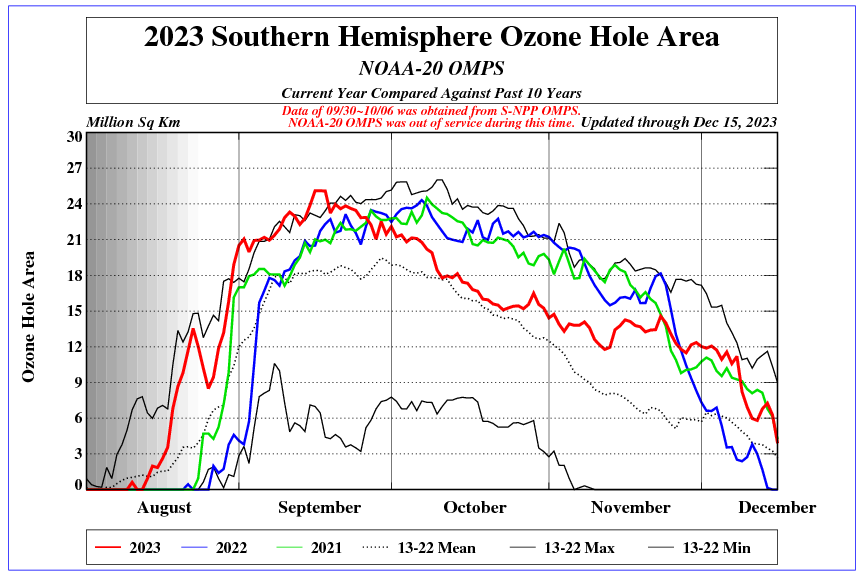 Ozone
Hole Size Ozone
Hole Size
Plots update August through December each year.
This figure shows the progress of the size of the ozone hole in comparison to other years.
Ozone hole size for previous years:
2024, 2023,
2022, 2021,
2020, 2019,
2018, 2017,
2016, 2015,
2014, 2013,
2012, 2011,
2010, 2009,
2008, 2007,
2006, 2005,
2004, 2003,
2002, 2001,
2000, 1999,
1998, 1997,
1996, 1995,
1994, 1993,
1992, 1991,
1990, 1989,
1988, 1987,
1986, 1985,
1984, 1983,
1982, 1981,
1980-79
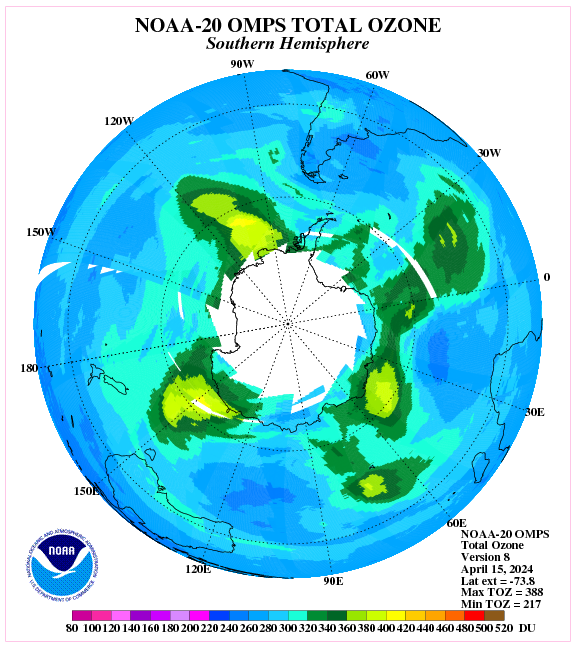 Southern Hemisphere Total Ozone Analyses
Southern Hemisphere Total Ozone Analyses
These maps shows the most recent analyis of the Southern Hemsisphere total ozone from the Ozone
Mapping and Profiler Suite (OMPS)
instrument on board the NOAA-20 and NOAA JPSS polar orbiting satellites. In austral spring the analyses show the "ozone
hole" (values below 220 Dobson Units)over Antarctica and the Antarctic Ocean. This
area of low ozone is confined by the polar vortex. Usually circular in August and
September, the vortex tends to elongate in October, stretching towards inhabited areas of
South America. By November, the polar vortex begins to weaken and ozone rich air begins to
mix with the air in the "ozone hole" region. The "ozone hole" is
usually gone by late November/early December.
The OMPS instruments can not make
observations in the polar night region because they relies upon bascscattered sun light. The blank area centered over the pole
represents the latitudes in which no observations can be made.
 Erythemal UV-B Daily
Dosage (Estimate) Erythemal UV-B Daily
Dosage (Estimate)
Influenced by depleted ozone within the Ozone Hole, surface UV-B radiation amounts can reach levels found only in the
tropics. This map shows the estimated daily dosage of erythemally weighted UV radiation. This estimate is based
upon the first 24 1-hour NOAA/EPA UV Index forecasts. The UV Index forecast values are assumed constant over the hour
of each of the 24 1-hour forecasts. The daily dosage is then the sum of all 24 1-hour forecasts. The UV
Index forecast is quite accurate for the first 24 hours. The UV Index forecast takes under consideration
the total column ozone amount, the sun-earth orientation, the surface elevation, the enhancement effects of snow and ice,
aerosol scattering (using a seasonal global climatology), and cloud UV transmission.
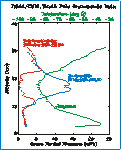 South
Polar Vertical Ozone Profile South
Polar Vertical Ozone Profile
This figure shows the vertical profile of ozone over the South Pole when the "ozone
hole" becomes well established. Nearly complete ozone depletion occurs between
13 km and 23 km, where extremely low temperatures support the heterogeneous photo-chemical destruction of
ozone. But, above and below these heights the air temperature is not low enough for this type
of ozone destruction, and ozone amounts remain virtually unchanged. The most recent ozone
soundings from the South Pole are available from NOAA's Earth System Research Laboratory - Global
Monitoring Division - South Pole Ozone Hole Monitoring.
 Time series of the
size of the S.H. polar vortex at 450K. Time series of the
size of the S.H. polar vortex at 450K.
Plots update April through December each year.
Air parcels
move on isentropic surfaces (surfaces of equal potential temperature) rather than pressure
surfaces. The 450 K surface in the south polar area lies between the 70 hPa and 50 hPa
pressure surfaces. This is near the altitude where ozone is in greatest abundance in
the vertical profile. This figure shows the size of the polar vortex with respect to previous years.
The polar vortex defines the area in which cold polar air is trapped by the very
strong winds of the Polar Night Jet. During the winter/spring period, when the polar
vortex is strongest, air outside of the vortex can not enter.
So, because the warm air from the mid latitudes can not mix with the cold polar
air, the polar air continues to get colder due to radiative loss of heat. Also, when ozone
in the vortex is depleted, it is not replenished with ozone rich air from outside the
vortex. Not until mid to late Spring does the polar vortex weaken and eventually break
down. After this, thorough mixing occurs and ozone amounts are replenished.
Previous years:
2025, 2024,
2023, 2022,
2021, 2020,
2019, 2018,
2017, 2016,
2015, 2014,
2013, 2012,
2011, 2010,
2009, 2008,
2007, 2006,
2005, 2004,
2003, 2002,
2001, 2000,
1999, 1998,
1997, 1996,
1995, 1994,
1993, 1992,
1991, 1990,
1989, 1988,
1987, 1986,
1985, 1984,
1983, 1982,
1981, 1980,
1979
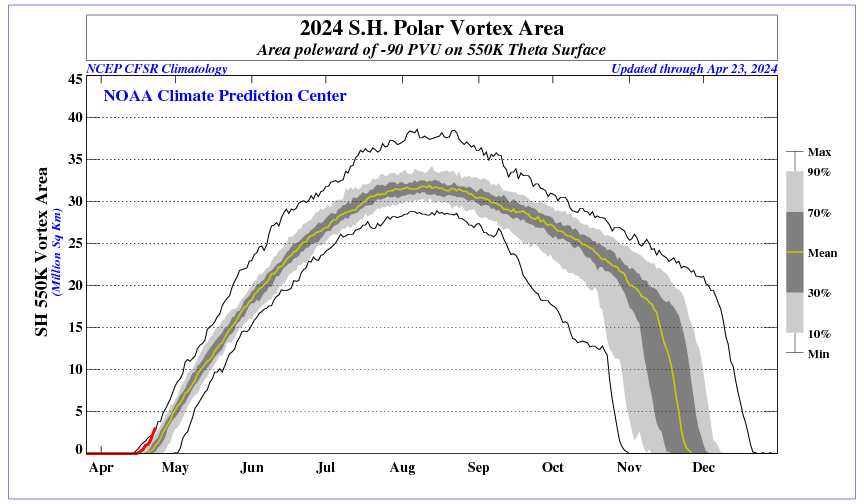 Time series of the
size of the S.H. polar vortex at 550K. Time series of the
size of the S.H. polar vortex at 550K.
Plots update April through December each year.
The 550 K surface in the south polar area lies between the 50 hPa and 30 hPa
pressure surfaces. This is near or slightly above the altitude where ozone is in greatest abundance in
the vertical profile. See the Vortex area at 450 K for more information.
Previous years:
2025, 2024,
2023, 2022,
2021, 2020,
2019, 2018,
2017, 2016,
2015, 2014,
2013, 2012,
2011, 2010,
2009, 2008,
2007, 2006,
2005
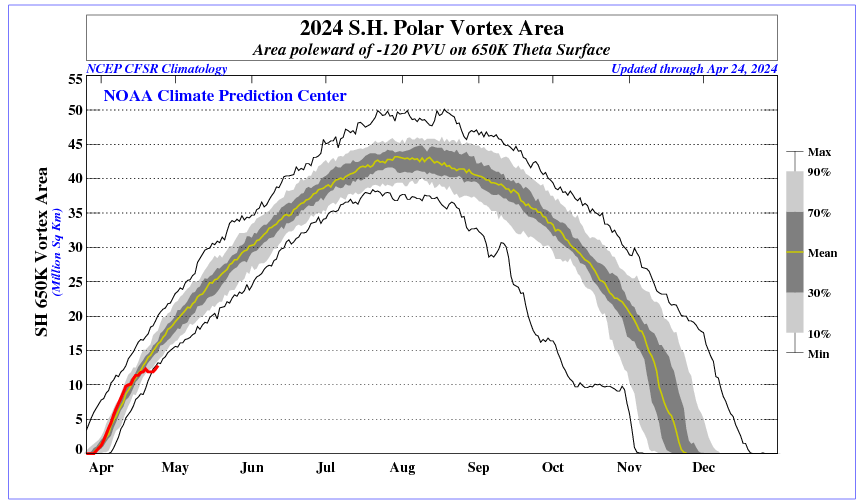 Time series of the
size of the S.H. polar vortex at 650K. Time series of the
size of the S.H. polar vortex at 650K.
Plots update April through December each year.
The 650 K surface in the south polar area lies between the 30 hPa and 20 hPa
pressure surfaces. This is above the altitude where ozone is in greatest abundance in
the vertical profile. See the Vortex area at 450 K for more information.
Previous years:
2025, 2024,
2023, 2022,
2021, 2020,
2019, 2018,
2017, 2016,
2015, 2014,
2013, 2012,
2011, 2010,
2009, 2008,
2007, 2006,
2005
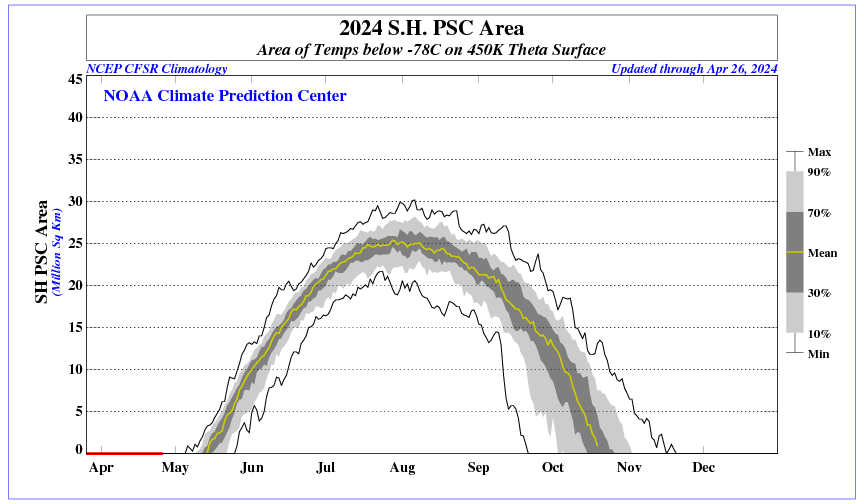 Time series of the
size of the air colder than -78C (PSC-1) at 450K. Time series of the
size of the air colder than -78C (PSC-1) at 450K.
Plots update April through December each year.
This figure shows the area within the polar vortex that has temperatures low enough to
form Polar Stratospheric Clouds (PSCs). The ice crystals that make up these PSCs are where
heterogeneous photo-chemical destruction of ozone take place. So as the area of low
temperatures becomes larger, there is greater liklihood of PSCs forming. When this area
becomes sunlit, enhanced ozone distruction takes place.
Previous years:
2025,
2024, 2023,
2022, 2021,
2020, 2019,
2018, 2017,
2016, 2015,
2014, 2013,
2012, 2011,
2010, 2009,
2008, 2007,
2006, 2005,
2004, 2003,
2002, 2001,
2000, 1999,
1998, 1997,
1996, 1995,
1994, 1993,
1992, 1991,
1990, 1989,
1988, 1987,
1986, 1985,
1984, 1983,
1982, 1981,
1980
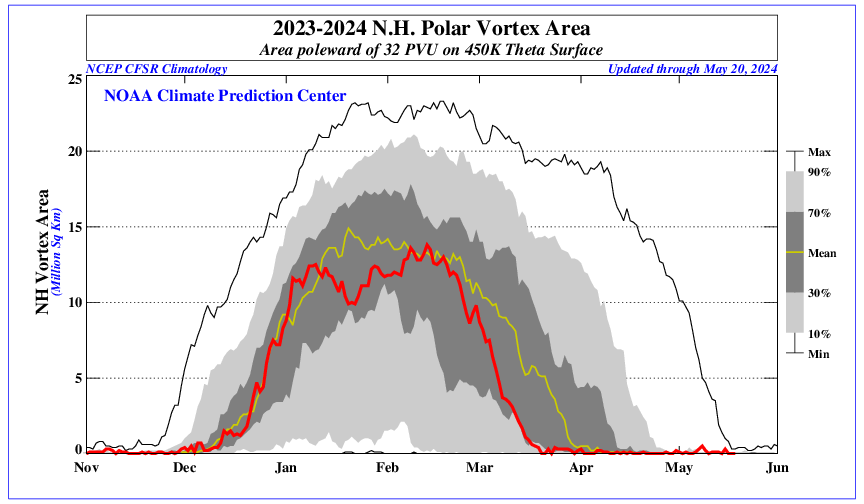 Time series of the
size of the N.H. polar vortex at 450K. Time series of the
size of the N.H. polar vortex at 450K.
Plots update November through May each year.
Air parcels
move on isentropic surfaces (surfaces of equal potential temperature) rather than pressure
surfaces. The 450 K surface in the north polar area lies between the 70 hPa and 50 hPa
pressure surfaces. This is near the altitude where ozone is in greatest abundance in
the vertical profile. This figure shows the size of the polar vortex with respect to previous years.
The polar vortex defines the area in which cold polar air is trapped by the very
strong winds of the Polar Night Jet. During the winter/spring period, when the polar
vortex is strongest, air outside of the vortex can not enter.
So, because the warm air from the mid latitudes can not mix with the cold polar
air, the polar air continues to get colder due to radiative loss of heat. Also, when ozone
in the vortex is depleted, it is not replenished with ozone rich air from outside the
vortex. Not until mid to late spring does the polar vortex weaken and eventually break
down. After this, thorough mixing occurs and ozone amounts are replenished.
Previous years:
2024-2025,
2023, 2022,
2021, 2020,
2019, 2018,
2017, 2016,
2015, 2014,
2013, 2012,
2011, 2010,
2009, 2008,
2007, 2006,
2005, 2004,
2003, 2002,
2001, 2000,
1999, 1998,
1997, 1996,
1995, 1994,
1993, 1992,
1991, 1990,
1989, 1988,
1987, 1986,
1985, 1984,
1983, 1982,
1981, 1980,
1979
 Time series of the
size of the air colder than -78C (PSC-1) at 450K over the northern
high latitudes. Time series of the
size of the air colder than -78C (PSC-1) at 450K over the northern
high latitudes.
Plots update November through May each year.
This figure shows the area within the polar vortex that has temperatures low enough to
form Polar Stratospheric Clouds (PSCs). The ice crystals that make up these PSCs are where
heterogeneous photo-chemical destruction of ozone take place. So as the area of low
temperatures becomes larger, there is greater liklihood of PSCs forming. When this area
becomes sunlit, enhanced ozone distruction takes place. The variability of NH polar temperatures is much greater than over
the SH polar region. Hence there is great year to year variability in PSC area. If a mid-winter stratospheric warming occurs, then
the NH polar region warms and temperatures generally do not get below the -78C threshold the remainder of the winter.
Previous years:
2024-2025,
2023, 2022,
2021, 2020,
2019, 2018,
2017, 2016,
2015, 2014,
2013, 2012,
2011, 2010,
2009, 2008,
2007, 2006,
2005, 2004,
2003, 2002,
2001, 2000,
1999, 1998,
1997, 1996,
1995, 1994,
1993, 1992,
1991, 1990,
1989, 1988,
1987, 1986,
1985, 1984,
1983, 1982,
1981, 1980,
1979
 South Poleward eddy heat
flux at 100 hPa. This time series shows the 10 day averaged eddy heat flux towards the South
Pole at 100 hPa. Strong negative fluxes indicate poleward flux of heat via eddies. Multiple stong poleward
episodes will result in a smaller polar vortex and an ealier transition from winter to summer circulations.
Relatively small flux amplitudes will result in a more stable polar vortex and will extend the winter circulation
well into November and December. South Poleward eddy heat
flux at 100 hPa. This time series shows the 10 day averaged eddy heat flux towards the South
Pole at 100 hPa. Strong negative fluxes indicate poleward flux of heat via eddies. Multiple stong poleward
episodes will result in a smaller polar vortex and an ealier transition from winter to summer circulations.
Relatively small flux amplitudes will result in a more stable polar vortex and will extend the winter circulation
well into November and December.
v'T' Previous Years:
2025,
2024,
2023,
2022,
2021,
2020,
2019,
2018,
2017,
2016,
2015,
2014,
2013,
2012,
2011,
2010,
2009,
2008,
2007,
2006,
2005,
2004,
2003,
2002,
2001,
2000,
1999,
1998,
1997,
1996,
1995,
1994,
1993,
1992,
1991,
1990,
1989,
1988,
1987,
1986,
1985,
1984,
1983,
1982,
1981,
1980
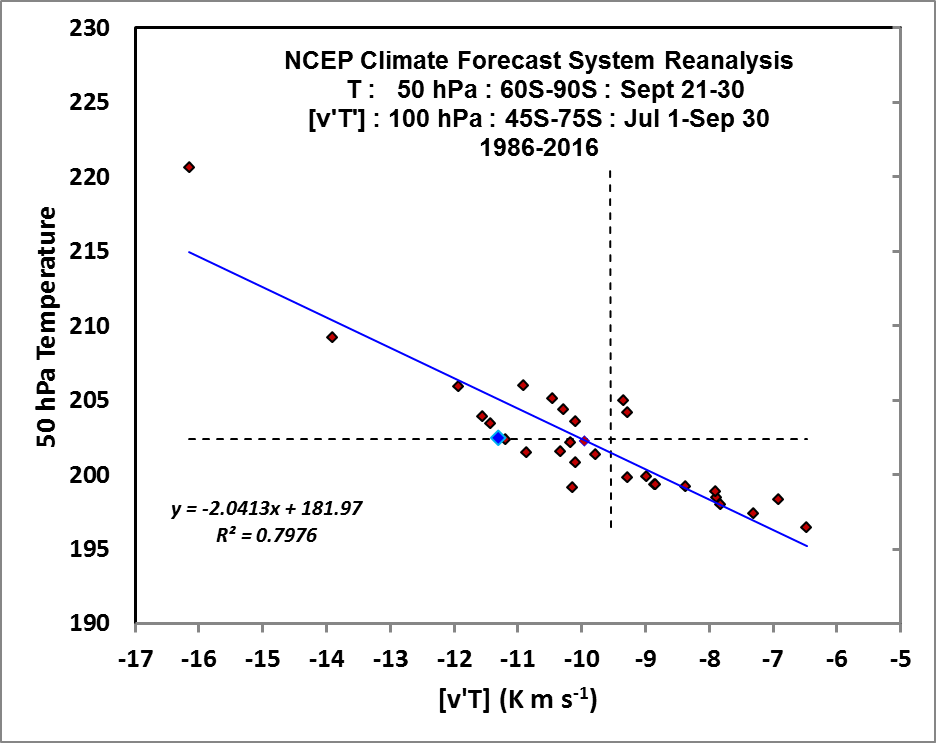 SH Polar Temperatures Relationship with Eddy Heat Flux. This plot shows the strong
relationship between the July-August-September eddy heat flux towards the South Pole at 100hPa and the
late September SH polar temperatures at 50hPa. The late September SH polar temperatures control how much
ozone is depleted and the ozone hole size and volume. The colder the temperatures, the greater the likelyhood of
Polar Stratospheric Clouds to form and the greater amount of photochemical distruction of ozone by
activated chlorine molecules. The 2016 relationship is shown as the blue diamond. The 1986-2016 means of the 50hPa Temp
and V'T' are shown as the horizontal and vertical lines, respectively.
SH Polar Temperatures Relationship with Eddy Heat Flux. This plot shows the strong
relationship between the July-August-September eddy heat flux towards the South Pole at 100hPa and the
late September SH polar temperatures at 50hPa. The late September SH polar temperatures control how much
ozone is depleted and the ozone hole size and volume. The colder the temperatures, the greater the likelyhood of
Polar Stratospheric Clouds to form and the greater amount of photochemical distruction of ozone by
activated chlorine molecules. The 2016 relationship is shown as the blue diamond. The 1986-2016 means of the 50hPa Temp
and V'T' are shown as the horizontal and vertical lines, respectively.
 North Poleward eddy heat flux at 100 hPa. This time series shows the 10 day averaged eddy heat flux towards the North
Pole at 100 hPa. Strong positive fluxes indicate poleward flux of heat via eddies. Multiple stong poleward
episodes may result in a Sudden Stratospheric Warming or a smaller/warmer polar vortex. Relatively small flux
amplitudes will result in a more stable/colder polar vortex and will extend the winter circulation further into the Spring. North Poleward eddy heat flux at 100 hPa. This time series shows the 10 day averaged eddy heat flux towards the North
Pole at 100 hPa. Strong positive fluxes indicate poleward flux of heat via eddies. Multiple stong poleward
episodes may result in a Sudden Stratospheric Warming or a smaller/warmer polar vortex. Relatively small flux
amplitudes will result in a more stable/colder polar vortex and will extend the winter circulation further into the Spring.
v'T' Previous Years:
2025,
2024,
2023,
2022,
2021,
2020,
2019,
2018,
2017,
2016,
2015,
2014,
2013,
2012,
2011,
2010,
2009,
2008,
2007,
2006,
2005,
2004,
2003,
2002,
2001,
2000,
1999,
1998,
1997,
1996,
1995,
1994,
1993,
1992,
1991,
1990,
1989,
1988,
1987,
1986,
1985,
1984,
1983,
1982,
1981,
1980
 Time vs. Pressure of Tnat in Southern Hemisphere.
[This figure will update May to December of each year.] This figure shows the
change with time of the area at various pressure levels at which the temperature
is below that which forms Polar Stratospheric Clouds(PSC) Type I (nitric acid trihydrate - NAT) and II
(ice). At low temperatures over the winter polar areas (195 K or -78 C), nitric acid (HNO3) and
sulfur-containing gases condense with water vapor to form solid and liquid PSC particles.
At even lower temperatures(188 K and -85 C), ice particles form.
These particles grow in size and number to create cloud-like features. PSCs cause
changes in the abundance of reactive chlorine gases. Reactions occur on the surfaces of PSCs that
convert reservoir forms of reactive chlorine, ClONO2 and HCl, into the most reactive form ClO.
Reactive chlorine then destroys ozone once sunlight returns to the polar area. Time vs. Pressure of Tnat in Southern Hemisphere.
[This figure will update May to December of each year.] This figure shows the
change with time of the area at various pressure levels at which the temperature
is below that which forms Polar Stratospheric Clouds(PSC) Type I (nitric acid trihydrate - NAT) and II
(ice). At low temperatures over the winter polar areas (195 K or -78 C), nitric acid (HNO3) and
sulfur-containing gases condense with water vapor to form solid and liquid PSC particles.
At even lower temperatures(188 K and -85 C), ice particles form.
These particles grow in size and number to create cloud-like features. PSCs cause
changes in the abundance of reactive chlorine gases. Reactions occur on the surfaces of PSCs that
convert reservoir forms of reactive chlorine, ClONO2 and HCl, into the most reactive form ClO.
Reactive chlorine then destroys ozone once sunlight returns to the polar area.
Tnat Previous Years:
2024, 2023,
2022, 2021,
2020, 2019,
2018, 2017,
2016, 2015,
2014, 2013,
2012, 2011,
2010, 2009,
2008, 2007,
2006, 2005,
2004, 2003,
2002, 2001,
2000, 1999,
1998, 1997,
1996, 1995,
1994, 1993,
1992, 1991,
1990, 1989,
1988, 1987,
1986, 1985,
1984, 1983,
1982, 1981,
1980, 1979
Tice Previous Years:
2024, 2023,
2022, 2021,
2020, 2019,
2018, 2017,
2016, 2015,
2014, 2013,
2012, 2011,
2010, 2009,
2008, 2007,
2006, 2005,
2004, 2003,
2002, 2001,
2000, 1999,
1998, 1997,
1996, 1995,
1994, 1993,
1992, 1991,
1990, 1989,
1988, 1987,
1986, 1985,
1984, 1983,
1982, 1981,
1980, 1979
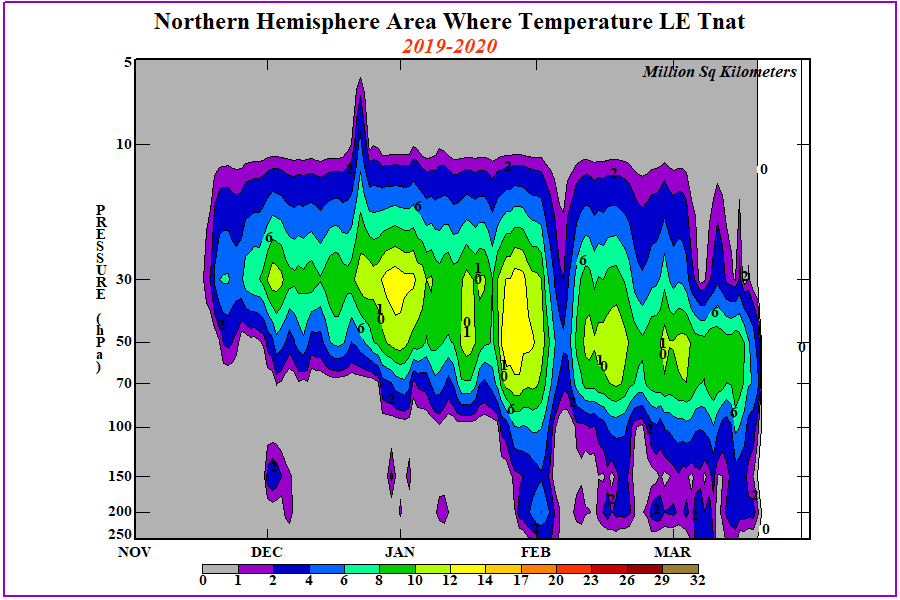 Time vs. Pressure of Tnat in Northern Hemisphere.
[This figure is not currently updating.] This figure shows the change with time of the
area at various pressure levels at which the temperature
is below that which forms Polar Stratospheric Clouds(PSC) Type I (nitric acid trihydrate - NAT).
At low temperatures over the winter polar areas (195 K or -78 C), nitric acid (HNO3) and
sulfur-containing gases condense with water vapor to form solid and liquid PSC particles.
At even lower temperatures(188 K and -85 C), ice particles form.
These particles grow in size and number to create cloud-like features. PSCs cause
changes in the abundance of reactive chlorine gases. Reactions occur on the surfaces of PSCs that
convert reservoir forms of reactive chlorine, ClONO2 and HCl, into the most reactive form ClO.
Reactive chlorine then destroys ozone once sunlight returns to the polar area. Time vs. Pressure of Tnat in Northern Hemisphere.
[This figure is not currently updating.] This figure shows the change with time of the
area at various pressure levels at which the temperature
is below that which forms Polar Stratospheric Clouds(PSC) Type I (nitric acid trihydrate - NAT).
At low temperatures over the winter polar areas (195 K or -78 C), nitric acid (HNO3) and
sulfur-containing gases condense with water vapor to form solid and liquid PSC particles.
At even lower temperatures(188 K and -85 C), ice particles form.
These particles grow in size and number to create cloud-like features. PSCs cause
changes in the abundance of reactive chlorine gases. Reactions occur on the surfaces of PSCs that
convert reservoir forms of reactive chlorine, ClONO2 and HCl, into the most reactive form ClO.
Reactive chlorine then destroys ozone once sunlight returns to the polar area.
Tnat Previous Years:
2020, 2019,
2018, 2017,
2016, 2015,
2014, 2013,
2012, 2011,
2010, 2009,
2008, 2007,
2006, 2005,
2004, 2003,
2002, 2001,
2000, 1999,
1998, 1997,
1996, 1995,
1994, 1993,
1992, 1991,
1990, 1989,
1988, 1987,
1986, 1985,
1984, 1983,
1982, 1981,
1980, 1979
 Time vs. Pressure of temperatures over the
South Pole. This figure shows the changes with time of
temperatures over the South Pole throughout the troposphere and stratosphere. Very cold air
dominates over the South Polar region during Austral Winter. Adiabatically warmed descending
air at the highest altitudes (lowest pressures) becomes apparent by mid September. The
dynamic heating and then solar heating (in spring time) spread with time throughout the
polar stratosphere, leading to the weakening and breakup of the S.H. stratospheric polar
vortex. Time vs. Pressure of temperatures over the
South Pole. This figure shows the changes with time of
temperatures over the South Pole throughout the troposphere and stratosphere. Very cold air
dominates over the South Polar region during Austral Winter. Adiabatically warmed descending
air at the highest altitudes (lowest pressures) becomes apparent by mid September. The
dynamic heating and then solar heating (in spring time) spread with time throughout the
polar stratosphere, leading to the weakening and breakup of the S.H. stratospheric polar
vortex.
The white contour outlines the altitudes and time of temperatures lower than -78 C, where
Polar Stratospheric Clouds may form.
Previous Years:
2025,
2024, 2023,
2022, 2021,
2020, 2019,
2018, 2017,
2016, 2015,
2014, 2013,
2012, 2011,
2010, 2009,
2008, 2007,
2006, 2005,
2004, 2003,
2002, 2001,
2000, 1999,
1998, 1997,
1996, 1995,
1994, 1993,
1992, 1991,
1990, 1989,
1988, 1987,
1986, 1985,
1984, 1983,
1982, 1981,
1980, 1979
Links
For more information about stratospheric processes , ozone depletion and
recovery check out these sites:
For ozone sounding information from Antarctica check out these sites:
|


